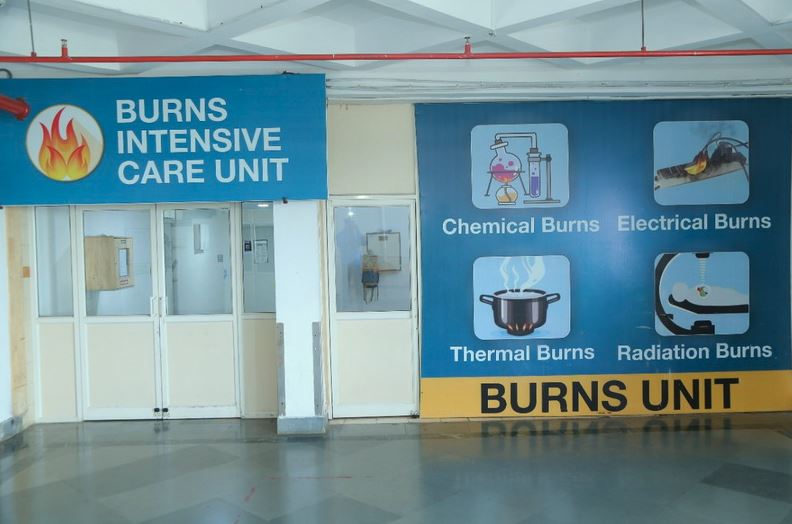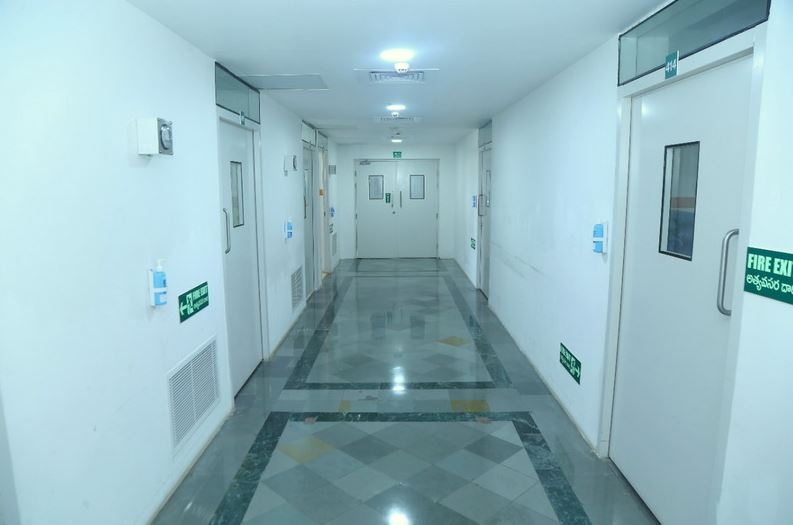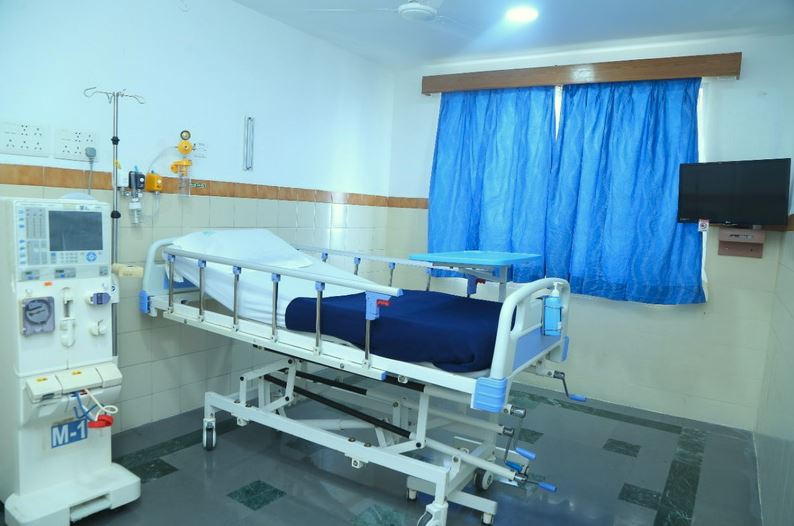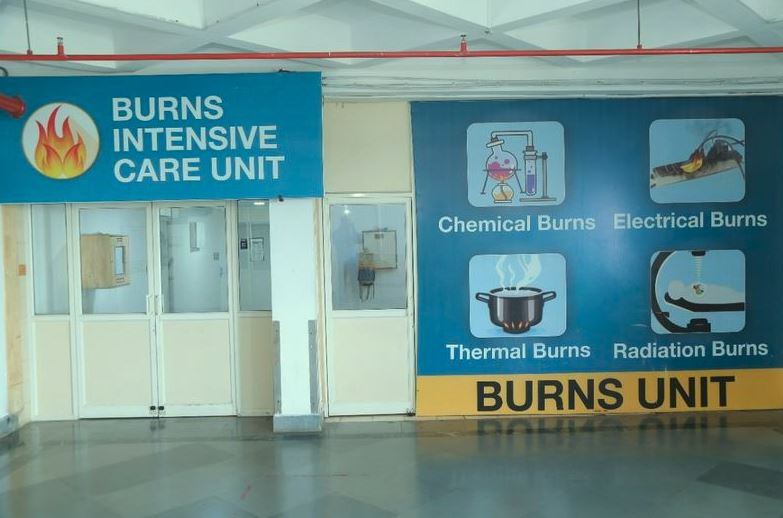Burns ICU in DRDO
Burns ICU
The Apollo Burns Intensive Care Unit (BICU) Center at Apollo DRDO Hospital is an advanced and fully equipped facility with double doors, centralized air conditioning, 10 well-furnished independent rooms with isolation, positive pressure ventilation and provisions for ventilator support.
With the most effective multidisciplinary approach to treating burns patients holistically, Apollo BICU consists of Burns Surgeons, Anesthesiologists, Respiratory Therapists, Intensive Care Specialists, Physiotherapists, Dieticians, Psycho-social Experts and fully trained, best Nursing Staff. The world-class Burns ICU has the best Burns Specialists who are available round-the-clock to take care of burns patients
With the availability of world-class, state-of-the-art infrastructure for burn patients, Apollo BICU center is considered to be the best in the States of Telangana and Andhra Pradesh.
Burns remains the most distressing injury that a man can receive. They can kill, and cause considerable suffering. Burns often need prolonged hospitalization and treatment. The impact of burns on community resources is tremendous. The patient may develop psychological problems due to life-long scarring. Clearly, prevention of burns is better than the cure.
FIRE
We use it in our daily lives for cooking, heating, celebrations, traditions and many other activities. When used safely, fire helps when misused, fire can destroy property and lives, causing serious burns and even death. NO one is immune to thermal injury.
HIGH RISK GROUP
- The very young
- The very old
- The very unlucky
- The very careless
CAUSES OF BURNS
- Thermal burns-accidental burns, suicidal burns and homicidal burns.
- Scalds-hot water & hot oil
- Chemical burns-acids & alkalis
- Electrical burns
- Radiation burns
RISK FACTORS
At home: In India majority of the burn injuries occur at home, especially in the kitchen. Various risk factors are floor level cooking, substandard kerosene stove, loosely worn garments (sari), low level electric plug points, carelessly kept match boxes within reach of children, substandard pressure cookers etc.
At work: Inadequate safety measures, overwork and fatigue are workplace. common risk factors at
At play: During Diwali, Indians play with firecrackers and celebrate the festival with lights. Inferior quality of crackers and carelessness during playing with it are important risk factors.
PREVENTION OF BURN INJURIES
Prevention does not mean only to reduce the incidence but also reduce the depth and severity of the burn. Cooling the burnt part with cold water is an important step to reduce the depth of burn injury.
Possible strategies for prevention of thermal burns by encouraging women to wear close fittingclothesin kitchen, avoid floor level cooking. keep children out of kitchen. Burn injuries due to fire crackers can avoided by igniting from a distance, do not wear easily flammable fabrics while playing with fire crackers. Avoid keeping hot liquids on the edge of the table to prevent accidental spillages, scalds to the children. Burn injury due to LPG leak can be easily detected by smell and avoid burn injury disaster at home by keeping the windows and doors open, avoid lighting the match stick and switching on the lights. Avoid wet hands while handling the electrical appliances to prevent dangerous and threatening electrical burn injuries.
GENERAL PREVENTIVE MEASURES IN CROWDED PLACES
- Heat and smoke detectors should be installed.
- A well designed fire escape plan should available.
- Fire and police numbers should be kept near phone.
- Fire extinguishers, water, sand should be kept ready.
- Training of permanent workers at fire accident prone places.
All over the world, millions of people sustain burns, many of them die, few of them are hospitalized and majority of them with minor burns are treated on an outpatient basis by primary care physicians. Whether the burn is major or minor, proper first- aid treatment may play a vital role in reducing mortality and morbidity. Proper first-aid treatment given in time can prevent the wound from becoming deep and getting infected. Proper care of the burn victims during transportation to referral centers can also play an important role in the final outcome.
FIRST-AID TREATMENT OF BURN VICTIMS
First-aid measures to be taken in burn patients depend on the type of burn – thermal, chemical or electrical.
THERMAL BURNS
Remove from heat source and extinguish fire: first of all, the fire should be put off by using a blanket, coat or such similar objects. This cuts off the oxygen supply which is necessary for burning clothes. Immediately after extinguishing the fire, the blanket and smouldering clothings should be removed to reduce the amount of heat delivered. If water is available at the site of accident, it should be used freely to existinguish the fire. To prevent undue contamination, dust, sand or other similar materials should be avoided to extinguish fire. The patient should be prevented from running unnecessarily which provides more oxygen to the burning clothes. If possible, the victim should be asked or made to lie down and roll on the ground. This will prevent facial burns and extension of the fire to upper clothings. If the accident occurs in closed space, the victim should be removed from the smoky enclosed space as quickly as possible. This will prevent or reduce the chance of carbon monoxide poisoning and inhalation injury. In case of scalds, hot and soaked clothings should be removed promptly.
KILL THE HEAT
The burn wound should be cooled as soon as possible with cool water, preferably between 8° C to 23 C° (45°F and 75°c F).cooling is effective for 30-60 minutes after injury, and is continued until pain no longer appears after cooling stops. Water must be “clean” but sterility is of no concern. Cool water stops the pain, removes the heat and lowers the temperature in the injured tissue. Cooling prevents further injury to the skin and increases the chances of survival of partially damaged living cells. Cooling increases the risk of hypothermia, especially in extensive burns and paediatric burns. To keep the victim warm, extensive burns in children or adults should be cooled for no longer than 5 minutes.
EXAMINE FOR ASSOCIATED TRAUMA
Any bleeding wound or associated fracture should receive proper first-aid treatment.
CARE OF AIRWAY:
Early intubation may be required in patients who are unconscious and who have an obvious inhalation injury.
PREVENT CONTAMINATION
All burn wounds are basically sterile wounds. Thus, every effort should be made to prevent contamination. The wound should be covered with freshly laundered handkerchief, towel or bedsheet. If possible, a first-aid non-adherent dressing should be done with water-soluble cream and paraffin-impregnated guaze. Application of gention violet or other dye should be avoided, because it will make the diagnosis of depth of burn difficult. Blisters should not be damaged during first aid dressing. Unruptured blisters will form a barrier for micro-organisms.
RELIEF OF PAIN
Choice of analgesic and route of administration depends on the severity of pain, age and the haemodynamic condition of the burn victim. In minor burn,oral analgesics are enough,but in case of large burns intravenous analgesics are indicated. Cooling with cool water and application of cool silver sulphadiazine cream also relieves pain to some extent.
CHEMICAL BURNS: (acids and alkalies) Washing with large amounts of water (preferable running water) should be started promptly. Washing will reduce the pain and extent of the burn injury. After washing the chemical thoroughly, contaminated clothes should be removed. When the eyes are involved, they must be thoroughly washed with water as quickly as possible.
Patients with chemical burns should be transported to the specialized burns center as early as possible.
ELECTRICAL BURNS
1. Switch off the electric supply and remove the victim away from source: The victim should be removed away from the electric source by wooden pole or chair, even if the electric supply is switched off.
2. Rescue from electric shock: Burn victims may develop respiratory failure or cardiac arrest, at this stage artificial respiration and external cardiac massage may be required to resuscitate the patient from electric shock.
TRANSPORTATION TO BURN CENTRE
Burn victims should be transferred to the burn centre as soon as possible, preferably within the first hour after the burn.
A qualified physician and nurse is a must during transportation. All victims with more than 10% burns should be started on IV FLUIDS, wound should be covered with freshly laundered cloth or if possible, with proper dressing. During transportation victim’s vital signs, urine output and oxygen saturation should be monitored and also an ambubag should be made available for hand ventilation.
Inform the burn centre regarding the approximate time of arrival and condition of the patient before starting the journey. This will provide adequate time to prepare the center for receiving the burn victim.
Handover the accurate and concise record of fluids and drugs given, vital signs and urine output chart to the burns casualty incharge to assure continuity of patient care.
For more information contact
Dr. Jagadish Jyothi
HOD, Plastic Surgery & BICU
Phone: +91-9133049444








